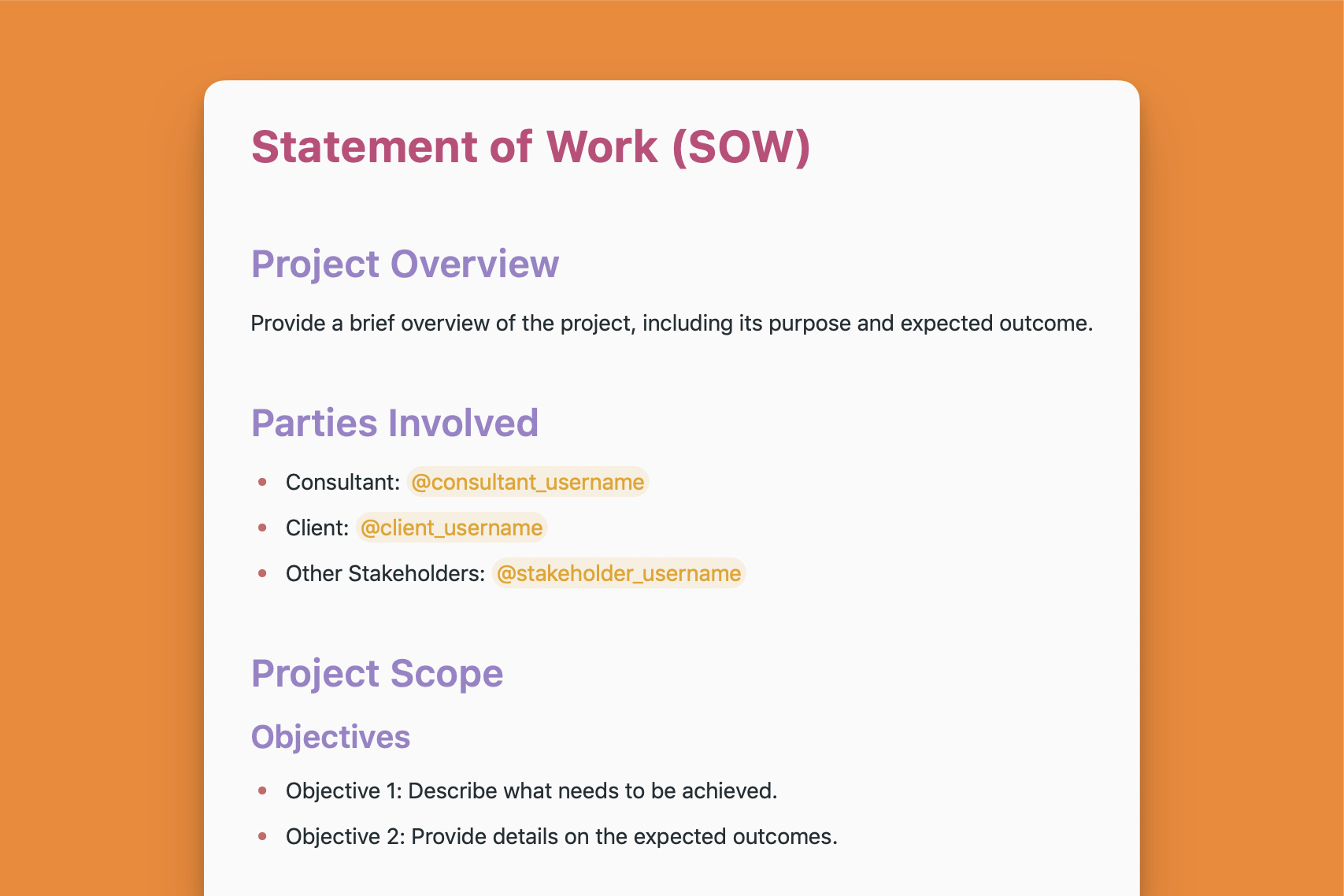Home

Statement of Work (SOW)
A detailed agreement outlining the scope, timeline, budget, and terms of a consulting project.

Meet
Get things done with NotePlan
Categories
The Statement of Work (SOW) template is a foundational document for any consulting project, providing a roadmap and agreement between the consultant and client. It outlines the project’s goals, scope, deliverables, timeline, and financial aspects, ensuring both parties are aligned and minimizing the potential for misunderstandings. A well-defined SOW provides clarity and focus throughout the entire project.
Let’s break down the key sections of this template:
Project Overview
This introductory section sets the stage by providing a concise summary of the project. It should clearly articulate the problem or opportunity the project addresses, the intended outcomes, and how the project will create value for the client.
Parties Involved
This is where all stakeholders are identified. Include the consultant, the client, and any other key individuals or organizations that will have an influence on the project’s success. The use of social media handles (@username) is a convenient way to ensure everyone can be easily contacted.
Project Scope
This is the heart of the SOW, detailing the project’s boundaries and parameters:
- Objectives: These are the specific, measurable goals the project aims to achieve.
- Deliverables: A table listing all the tangible items (reports, analyses, recommendations, etc.) that the consultant will provide throughout the project.
- Exclusions: Clearly state what the project will not cover. This prevents scope creep and manages expectations.
Timeline
This section sets a realistic schedule for the project:
- Milestones: Significant checkpoints in the project, marking the completion of major phases.
- Key Dates: The start and end dates, as well as any scheduled reviews or meetings.
Budget
Transparency about finances is crucial:
- Costs Breakdown: A detailed list of the consultant’s fees, including any travel or material expenses.
- Payment Schedule: The agreed-upon payment plan, outlining when invoices will be sent and expected payment dates.
Terms and Conditions
This section covers the legal aspects of the agreement. It might include clauses on:
- Confidentiality of information
- Data protection and ownership
- Termination of the contract
- Dispute resolution processes
Approval
Both the consultant and the client formally sign off on the SOW, indicating their agreement to all the terms within. Digital signatures can be used for convenience.
Tasks
This optional checklist serves as a reminder of the immediate steps needed to finalize the SOW and get the project started.
Additional Tips
- Be specific and detailed: Avoid vague language or generalizations.
- Use plain English: Write in a way that’s easily understandable to everyone involved.
- Get legal advice: If needed, consult an attorney to ensure the SOW is legally sound.
Why a Thorough SOW Matters
A well-crafted SOW is a powerful tool for managing client expectations, preventing miscommunication, and ensuring the successful completion of your project. It serves as a reference document throughout the engagement, providing clarity and guidance for all parties involved.
What is a Statement of Work?
A Statement of Work (SOW) is a crucial document in project management that outlines the scope of work, deliverables, and timeline for a project. It acts as a contract between a client and a service provider, ensuring that both parties are on the same page regarding the project’s objectives, scope, and expectations. By clearly defining these elements, a well-crafted SOW helps to prevent misunderstandings, miscommunications, and scope creep, setting the stage for a successful project.
Key Components of a Statement of Work
A comprehensive SOW typically includes the following key components:
- Project Scope and Objectives: A clear description of the project’s goals, deliverables, and timelines.
- Roles and Responsibilities: A definition of the roles and responsibilities of all stakeholders involved in the project.
- Deliverables: A list of specific deliverables, including their descriptions, timelines, and acceptance criteria.
- Timeline: A detailed project schedule, including milestones, deadlines, and critical path activities.
- Payment Terms: A description of the payment terms, including the payment schedule, amount, and method.
- Assumptions and Dependencies: A list of assumptions and dependencies that may impact the project’s success.
- Risks and Mitigation Strategies: A description of potential risks and mitigation strategies to address them.
Project Scope and Objectives
The project scope and objectives section of the SOW should provide a clear and concise description of the project’s goals, deliverables, and timelines. This section should include:
- Project Overview: A brief description of the project, including its purpose, goals, and objectives.
- Scope Statement: A detailed description of the project’s scope, including what is included and excluded.
- Deliverables: A list of specific deliverables, including their descriptions, timelines, and acceptance criteria.
- Key Performance Indicators (KPIs): A description of the KPIs that will be used to measure the project’s success.